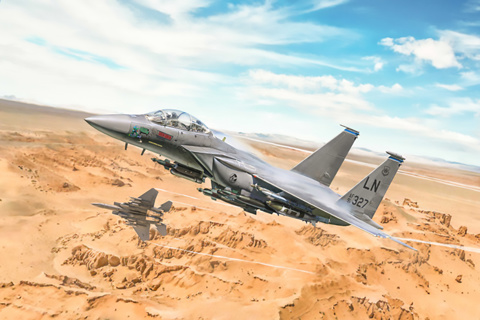F-15E Strike Eagle
Item No. 2803
The McDonnell Douglas F-15 Eagle design was initiated in the 1970s to equip the United States Air Force fighter squadrons with an advanced and high-performance jet fighter. The effective and robust aerodynamically design lay-out led to production of the two-seat “all-weather” F-15E Strike Eagle figh
Description
The McDonnell Douglas F-15 Eagle design was initiated in the 1970s to equip the United States Air Force fighter squadrons with an advanced and high-performance jet fighter. The effective and robust aerodynamically design lay-out led to production of the two-seat “all-weather” F-15E Strike Eagle fighter-bomber. Entering into service with the USAF in the late 1980s and replacing the outdated F-111, its operational roles included ground attack, bombing and interdiction missions. It retained the flight design characteristics of the original F-15 such as the two tail drifts, sturdy mid-wing and tandem two-seater cabin, in the rear of which was the Weapon Systems Officer. From this position the officer selected the aircraft’s route management, target tracking and electronic countermeasures. The F15-E was deployed to numerous operational theaters such as the Desert Shield and Desert Storm campaigns of the early 1990s.
F-15E Strike Eagle
Item No. 2803
The McDonnell Douglas F-15 Eagle design was initiated in the 1970s to equip the United States Air Force fighter squadrons with an advanced and high-performance jet fighter. The effective and robust aerodynamically design lay-out led to production of the two-seat “all-weather” F-15E Strike Eagle figh
Description
The McDonnell Douglas F-15 Eagle design was initiated in the 1970s to equip the United States Air Force fighter squadrons with an advanced and high-performance jet fighter. The effective and robust aerodynamically design lay-out led to production of the two-seat “all-weather” F-15E Strike Eagle fighter-bomber. Entering into service with the USAF in the late 1980s and replacing the outdated F-111, its operational roles included ground attack, bombing and interdiction missions. It retained the flight design characteristics of the original F-15 such as the two tail drifts, sturdy mid-wing and tandem two-seater cabin, in the rear of which was the Weapon Systems Officer. From this position the officer selected the aircraft’s route management, target tracking and electronic countermeasures. The F15-E was deployed to numerous operational theaters such as the Desert Shield and Desert Storm campaigns of the early 1990s.

